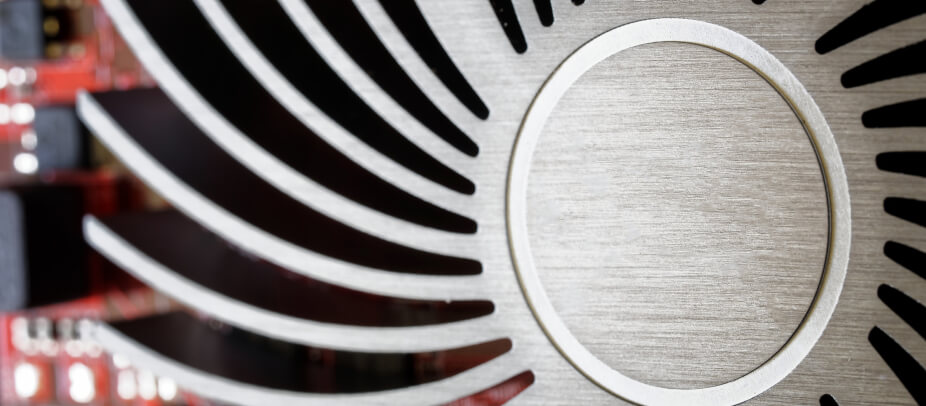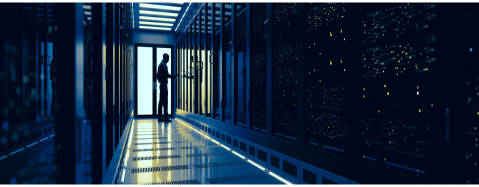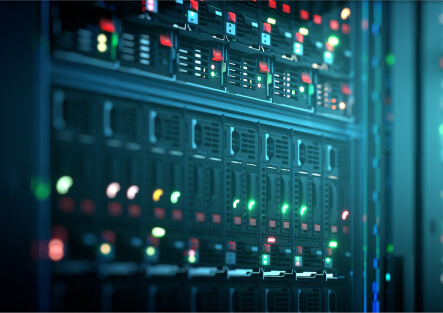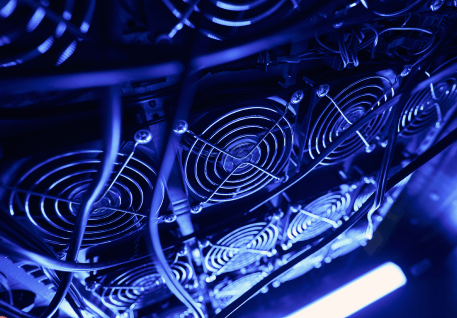Thermal Management Buyer’s Guide
Thermal Management Buyer's Guide
Introduction to Thermal Management
What is Thermal Management?
Thermal management is the practice of controlling the temperature and airflow in a designated area to ensure that electronic equipment, such as servers and networking devices, operate within their recommended temperature ranges. This involves the use of cooling systems, such as air conditioning units and/or liquid cooling, to dissipate the heat generated by the equipment.
Thermal management prevents the devices from overheating, which can cause damage and lead to system failure. Proper use of thermal management ensures the reliability and longevity of equipment, as well as improves energy efficiency and reduces operating costs.

Why is Thermal Management Important?
Thermal management contributes to your business’ success for several reasons:
01 – Equipment Reliability: Electronic equipment, such as servers and networking devices, operate best within a certain temperature range. If the temperature gets too hot, the equipment may experience thermal stress, which can lead to component failure and downtime.
02 – Energy Efficiency: By managing the temperature in a data center, it is possible to reduce the amount of energy required for cooling. This can lead to significant cost savings on energy bills.
03 – Environmental Impact: The energy used to cool a data center has a significant environmental impact, particularly in terms of greenhouse gas emissions. By managing the temperature in a data center, it is possible to reduce the environmental impact of cooling.
04 – Capacity Utilization: Proper thermal management can help maximize the capacity utilization of a data center because it can help ensure that equipment is running optimally and that there is sufficient cooling capacity to support high-density deployments.
Overall, thermal management is essential for ensuring the reliable operation of equipment while minimizing energy costs and environmental impact.

Overview of Thermal Management Products
There are a variety of thermal management products available for data centers, data closets or whatever space a business may house its equipment. These products are designed to help control the temperature and airflow within the space, ensuring that electronic equipment operates within recommended temperature ranges. Some of the most common thermal management products include:
Air Conditioning Units: Air conditioning units are the most common method for cooling data centers. They work by circulating cool air around the facility, which absorbs heat from the electronic equipment and is then expelled outside.
Liquid Cooling Systems: Liquid cooling systems are an alternative to air conditioning units. They work by circulating a liquid coolant through a system of pipes. The coolant absorbs heat from the electronic equipment and is further cooled in an external radiator. Liquid cooling systems are often more efficient than air conditioning units, but they can be more expensive to install.
Hot Aisle/Cold Aisle Containment: Hot aisle/cold aisle containment is a technique used to control the airflow within a data center. It involves separating the data center into two distinct zones: a hot aisle, where the hot air from the electronic equipment is expelled, and a cold aisle, where cool air is delivered to the equipment. This can help reduce the mixing of hot and cold air, which improves cooling efficiency.
In-Row Cooling: In-row cooling involves installing cooling units directly in the rows of server racks. This can help reduce the distance that the cool air needs to travel, which improves cooling efficiency and reduces energy consumption.
Heat Exchangers: Heat exchangers are devices that transfer heat from one fluid to another. They can be used in conjunction with liquid cooling systems to further improve cooling efficiency.
Overall, there are many thermal management products available for data centers. The choice of product will depend on a variety of factors, including the size of the data center, the layout of the equipment, and the desired level of efficiency.
Understanding Heat Generation

What Causes Heat Generation in the First Place?
Heat is generated from the operation of electronic equipment, such as servers, storage systems, and networking devices. As these devices process data and perform computations, they generate heat due to the resistance of electrical current flowing through their components.
The heat generated by these devices can be significant, particularly in high-density deployments where there are many devices operating in a small space. Other factors that can contribute to heat generation in data centers include lighting, ventilation systems, and external environmental factors such as temperature and humidity.
Additionally, inefficiencies in power distribution and cooling systems can result in excess heat generation. Proper thermal management is essential for controlling the amount of heat that comes from these factors and ensuring that electronic equipment operates within its recommended temperature range.
Types of Heat
Sensible heat is also called dry heat. It is the heat that can be sensed or measured with a thermometer that is created by electronic equipment, such as servers and networking devices, as they process data and perform computations. Sensible heat can be easily measured and controlled using thermal management systems.
Latent heat is simply described as the moisture from people. It is the heat generated by the process of evaporation or condensation of moisture in the air. In a data center, latent heat is typically generated using air conditioning units or other cooling systems, which cool the air and remove moisture. The cooling process causes the moisture in the air to condense, which generates latent heat. Latent heat can be more difficult to measure and control than sensible heat because what causes it can vary or be arbitrary at any given time, but it is an important factor in the design of cooling systems for data centers.
Both sensible and latent heat must be managed in data centers to ensure that electronic equipment operates within its recommended temperature range. This requires the use of thermal management systems, such as air conditioning units, liquid cooling systems, or other cooling technologies, to remove heat from the data center and maintain the desired temperature and humidity levels.
What Factors Affect Heat Generation?
Several factors can affect the heat generation of electronic equipment in data centers.
Some of the most significant factors include:
Workload: The workload of the electronic equipment can have a significant impact on the amount of heat generated. Higher workloads, such as those associated with processing large amounts of data or running complex computational tasks, can generate more heat.
Redundancy: Redundant equipment, such as backup power supplies or redundant network switches, can generate additional heat.
Age: The age of the electronic equipment can also be a factor in heat generation. Older equipment may be less energy-efficient and generate more heat than newer equipment.
Density: The density of electronic equipment in the space can also affect heat generation. High density deployments, where there are many devices operating in a small space, can generate more heat than lower density deployments.
Power Usage Effectiveness (PUE): PUE is a measure of the energy efficiency of the space. Spaces with a higher PUE may generate more heat, as more energy is required to operate the facility.
Location: The location of the equipment can also affect heat generation. Data centers located in warmer climates may require more cooling to maintain the desired temperature, which can result in increased heat generation.
Overall, the factors that affect heat generation in data centers are numerous and complex. Effective thermal management strategies must take into account these factors and be tailored to the specific needs of the data center to ensure optimal performance and efficiency.
Types of Thermal Management Products
Heat Rejection Units
HRUs are an essential component of thermal management systems. These units are commonly referred to as condensers, where they condense the refrigerant from a gas to a liquid to remove heat from the area and expel it outside. They are designed to improve your efficiency, lower costs, and improve your thermal management.
There are many types of heat rejection units on the market, including dry coolers, air-cooled condensers and other systems. Each has its own advantages. A drycooler, also called a fluid cooler, is one of the more popular types of heat rejection systems used in data centers. A drycooler manages heat rejection for a water loop. Don’t let the name fool you. It is called a drycooler for the process it performs but it’s actually full of liquid to get the job done.
Some of the most popular heat rejection units we offer include:
Liebert MC Microchannel Outdoor Condenser: The Liebert MC Microchannel Condenser is an outdoor air-cooled condenser that provides higher efficiency, while using less refrigerant. Features such as variable speed fans, advanced controls and a microchannel coil make this system uniquely innovative. It operates at a higher efficiency than fin and tube condensers, with an annual savings of up to 85%.
Liebert Outdoor Drycooler: Liebert outdoor drycoolers provide freecooling and reliable heat rejection, using pumped glycol heat-transfer fluid. This is highly durable, operates well in low temperatures and is quiet to meet municipal noise codes.
Liebert Piggyback Indoor Drycooler: These indoor drycoolers provide solutions for applications where outdoor heat rejection locations are not practical, such as high-rise buildings or areas with restricted access. Six models are available to cover a wide range of applications with flexible configurations that are easy to install.
Pros
- Efficient Cooling: HRUs help to remove heat from the data center and reject it to the outside environment. This helps to keep the temperature within the data center within acceptable limits, which is essential for the efficient operation of the servers.
- Environmentally Friendly: HRUs can be an environmentally friendly option for cooling data centers. For example, if the HRUs use freecooling (i.e., using outdoor air to cool the data center), they can significantly reduce energy consumption and carbon emissions.
- Cost-Effective: HRUs can be an effective way to manage the temperature in data centers, as they are often less expensive than other cooling options such as air conditioning units.
Cons
- Limited Cooling Capacity: HRUs have limited cooling capacity and may not be able to handle large amounts of heat produced by the servers. This can result in the temperature within the data center rising above acceptable limits, leading to equipment failures and downtime.
- Maintenance: HRUs require regular maintenance to ensure that they continue to operate efficiently. This can add to the overall cost of running a data center.
- Dependence on Weather Conditions: If the HRUs use freecooling, they are dependent on favorable weather conditions to operate efficiently. For example, if the outside temperature is too high, it may not be possible to use freecooling to cool the data center effectively.
- Noise: HRUs can generate noise, which can be a concern if the data center is located in a residential area. This can also be a concern if the data center is located in a multi‑tenant building.
High-Density Solutions
To satisfy the immense amounts of data needed at the fingertips of the user, you need to increase the power density in your data center. But high-power densities also need high-density cooling systems. These are holistic cooling solutions that include refrigerant-based cooling modules or pumping and chiller units, floor mount, ceiling-mount or rack cooling systems designed to keep the temperature of your IT equipment at the optimum levels.
Some of the most popular options we offer include:
Liebert XDM Split Indoor Chiller: Designed to remove barriers to liquid cooling in an air-cooled environment, the Liebert XDM Split Indoor Chiller is a liquid-to-fluid exchanger for rear door cooling applications that offers easy, cost-effective deployment in any data center. The unit operates without your facility’s water and provides a chilled water secondary circuit allowing you to tap into the benefits of water-cooled doors to more efficiently support higher rack densities without incurring the costs of major infrastructure changes.
Liebert XDU Coolant Distribution Units: Designed to support liquid cooling within high density environments, the Liebert® XDU Coolant Distribution Units are suitable for chip and rear door cooling applications that offer easy, cost-effective deployment in any data center. The Liebert XDU family offers systems that operate with/without your facility’s water, allowing you to tap into the benefits of liquid-cooled servers to more efficiently support higher rack densities without incurring the costs of major infrastructure changes.
Pros
- Space-Saving: High-density solutions allow for more electronic equipment to be deployed in a smaller physical space, which can be a significant advantage for data centers that are constrained by physical limitations.
- Energy-Efficient: High-density solutions can be more energy-efficient than lower density deployments, as they can reduce the need for additional infrastructure such as cabling and networking equipment.
- Cost-Effective: High-density solutions can be more cost-effective than lower density deployments, as they can reduce the amount of floor space required, which can lower the cost of rent, utilities, and other expenses.
Cons
- Heat Generation: High-density deployments generate more heat, which can be a significant challenge for data centers to manage. Effective thermal management solutions must be in place to remove the excess heat and prevent damage to electronic equipment.
- Higher Cooling Costs: High-density deployments can require more cooling infrastructure and energy to maintain the desired temperature, which can increase the cost of operating the facility.
- Increased Complexity: High-density deployments can be more complex to design, deploy, and maintain, which can increase the risk of equipment failure and downtime.

Outdoor Packaged Systems
The rise of Internet of Things and its vast applications, combined with the performance brought to the table by the edge computing enabled early 5G deployments have one thing in common: rising energy costs. And that is why businesses need a thermal management system to reach new levels of energy efficiency.
Outdoor packaged systems consist of one or more packaged air conditioning units that are installed outside the data center and connected to the data center’s cooling infrastructure. Whether you’re thinking of direct expansion cooling solutions, a freecooling system or an indirect evaporative cooling mechanism, outdoor packaged cooling systems are a good option.
Some of the most popular options we offer include:
Liebert DSE Packaged Free-Cooling Solution, 400-500kW: Reduce costs and increase economization hours with the highly efficient Liebert® DSE Packaged Free-Cooling Solution. The Liebert DSE is the world’s most widely deployed pumped refrigerant economization system for data centers, with over 8,500 installations. It eliminates water usage, cost and treatment, is highly efficient in low load/part load conditions and is rapidly scalable for faster deployment.
Pros
- Efficient Cooling: Outdoor packaged systems are designed to provide efficient cooling for data centers. They can handle large amounts of heat and are capable of maintaining a constant temperature within the data center.
- Easy to Install: Outdoor packaged systems are relatively easy to install, as they are pre-engineered and pre-built. This can save time and money compared to other cooling options.
- Modular Design: Outdoor packaged systems are modular in design, which means that they can be easily expanded or downsized as needed. This makes them a flexible and scalable option for cooling data centers.
- Space Saving: Outdoor packaged systems can help to save space within the data center, as they are installed outside the building. This can be particularly beneficial for data centers with limited space.
- Reduced Noise: Outdoor packaged systems are located outside the data center, which can help to reduce the noise levels within the building.
Cons
- Maintenance: Outdoor packaged systems require regular maintenance to ensure that they continue to operate efficiently. This can add to the overall cost of running a data center.
- Initial Cost: The initial cost of installing an outdoor packaged system can be higher than other cooling options. However, long-term energy savings may offset this cost over time.
- Weather Dependence: Outdoor packaged systems can be affected by adverse weather conditions, such as high temperatures, high humidity, or extreme weather events. This can affect their ability to cool the data center effectively.
- Reliability: Like all mechanical systems, outdoor packaged systems can experience equipment failures or breakdowns. This can lead to downtime and impact the reliability of the data center.
Room Cooling
Whether your equipment is housed in a small network closet, or an entire room devoted to just the devices, a business’ approach to air conditioning should be viewed holistically. When taking this approach, you will have cutting-edge room cooling solutions that support a vast range of applications.
Room cooling systems use air conditioning units to cool the air in the room where the servers are located. Large room cooling solutions offer you exceptional thermal management for your large-scale environment. These units boast a variety of configurations, including raised-floor and ducted applications. They also provide air, water, chilled liquid, glycol, and EconoPhase options. These large room cooling solutions are available in sizes from 8 – 60 tons (28 – 240kW).
Some of the most popular options we offer include:
Liebert DS Direct Expansion Cooling System: As the world’s most flexible and reliable direct expansion data center cooling system, the Liebert DS improves data center efficiency and protection. The system uses the industry’s most advanced thermal controls and features a modular design, multiple compressor options and easy service access.
Liebert PDX Compact DX Cooling System, 11-29kW: The Liebert PDX direct expansion cooling system offers the industry’s highest efficiency, protection and capacity per footprint for server room cooling, network closets and other small spaces. It offers the highest capacity per footprint, flexible configurations that simplify installation and advanced thermal controls.
Liebert DSE Free-Cooling Economization System, 50-256kW: The Liebert DSE is the world’s most widely deployed pumped refrigerant economization system with advanced thermal controls and a microchannel condenser. This system minimizes compressor use to maximize freecooling, eliminates the need to bring outside air and contaminants into the space and has no dampers or louvers to maintain.
Pros
- Precise Temperature Control: Room cooling systems can provide precise temperature control for data centers, which is important for the efficient operation of the servers.
- Easy to Install: Room cooling systems are relatively easy to install, especially compared to other cooling options that require extensive ductwork and other infrastructure.
- Energy-Efficient: Room cooling systems can be more energy-efficient than other cooling options, such as traditional air conditioning units, because they only cool the specific area where the servers are located.
- Flexibility: Room cooling systems are flexible and can be adapted to meet the changing cooling needs of a data center. They can also be used in a variety of different environments, including small server rooms and large data centers.
- Reduced Noise: Room cooling systems can help to reduce the noise levels within a data center because they are designed to operate quietly.
Cons
- Inefficient Use of Space: Room cooling systems can take up valuable floor space within a data center, which can be a concern in data centers with limited space.
- Limited Cooling Capacity: Room cooling systems have a limited cooling capacity and may not be able to handle large amounts of heat produced by the servers. This can result in the temperature within the data center rising above acceptable limits, leading to equipment failures and downtime.
- Maintenance: Room cooling systems require regular maintenance to ensure that they continue to operate efficiently. This can add to the overall cost of running a data center.
- Dependence on Room Layout: Room cooling systems are dependent on the layout of the data center. If the layout is not optimized for airflow, it can lead to hot spots and uneven cooling within the room.
Small Room In-Row Cooling
Small room thermal management systems offer superior cooling and humidity control, space saving configurations, and a variety of mounting options like in-row cooling. The solutions are specifically designed to save space and protect electronic equipment in small spaces.
Some of the most popular options we offer include:
Liebert CRV In-Row Cooling System, 10-40kW: The Vertiv™ Liebert® CRV is a precision data center cooling solution, integrated within a row of data center racks and was designed to address some of the major challenges seen in high density applications. With adjustable airflow baffles and controls that independently manage airflow and temperature, the Liebert CRV can precisely deliver highly efficient cooling in the row where it’s needed. The system is available in multiple options, providing flexibility for any installation.
Liebert Mini-Mate, Ceiling-Mounted Variable Capacity Cooling: The New Liebert Mini-Mate 3, 4 and 5-ton (10.5, 14 & 17.5kW) variable capacity system is an efficient and reliable ceiling-mounted precision cooling system for edge computing and other small IT spaces. It saves customers money and increases IT protection through a high-efficiency variable capacity design, fast installation, lower maintenance requirements, and built-in remote monitoring and management.
Liebert DataMate Mission Critical Cooling System, 5-10.5kW: Liebert DataMate is a small footprint cooling system for 7×24 temperature and humidity control in network closets, computer rooms and other small spaces. Its low profile permits floor-mount or wall-mount installation and requires little or no floor space. It provides simplified, year-round temperature and humidity control and air filtration.
Pros
- Highly Efficient: In-row cooling systems are designed to be placed directly next to the IT equipment they are cooling, which makes them very efficient at removing heat.
- Scalable: In-row cooling systems can be easily scaled up or down to meet the needs of a particular data center or IT environment.
- Space-Saving: By placing cooling units directly in the row of IT equipment, in-row cooling systems can help reduce the need for additional cooling units or infrastructure, saving space in the data center.
- Easy to Install: Small room thermal management systems are generally easy to install, especially if they are designed to be self contained units.
- Cost-Effective: Small room thermal management systems can be a more cost effective option than in-row cooling, especially for smaller IT environments.
- Flexible: Small room thermal management systems can be used in a variety of settings, from server rooms to remote locations, making them a versatile option.
Cons
- Higher Cost: In-row cooling systems can be more expensive than other types of cooling solutions, especially if they are highly advanced and feature-rich.
- Maintenance Requirements: In-row cooling systems require regular maintenance to keep them running efficiently and to prevent downtime.
- Limited Scalability: Small room thermal management systems may not be able to accommodate larger IT environments, which could limit their usefulness in the long term.
- Limited Efficiency: Depending on the design of the system, small room thermal management solutions may not be as efficient at removing heat as in-row cooling solutions.
Rack Cooling
Higher data transfer speeds, low latency, and constant availability require more computing power, which in turn means higher power densities per rack. For performance requirements to be achieved, the servers in the rack must operate at peak capacity and within the optimum temperature. Businesses can effectively manage the higher heat loads generated by tightly packed electronic enclosures in their racks by designing customizable thermal management systems.
Rack cooling systems incorporate precision air conditioning directly into the rack. This design eliminates the need for a precision room air conditioner, increases efficiency and is rapidly deployable. Self-contained rack solutions range in size from 1/2 to 10 tons (1.6-40kW).
Some of the most popular options we offer include:
Vertiv Geist SwitchAir: Network switches, load balancers and routers typically sit at the top and back portion of the rack, away from the cold aisle airflow at the front of the cabinet. This placement makes it difficult for cold air to flow from the front of the rack to the air intakes of the network switch equipment, increasing the chances of failure over time. SwitchAir helps prevent failure by channeling cool air from the front of the rack to the air intakes regardless of where the equipment is mounted.
Vertiv VRC Rack Cooling System, 3500 Watts: The Vertiv™ VRC rack-mounted IT cooling unit packs powerful, scalable cooling into a compact unit and has been designed to tackle some of the biggest challenges seen in edge environments. Its variable speed components provide up to 3.5 kW of scalable cooling capacity, while its compact footprint saves valuable IT floorspace for critical equipment. It is available in a self contained and split version, allowing for flexible installation regardless of building architecture or existing equipment.
For more specific information on the variety of rack systems available to you, read our Rack Systems Buyer’s Guide.
Thermal Control and Monitoring
Leveraging your thermal management systems to support business objectives, such as improving energy efficiency and cutting costs, takes superior system insight and control.
Continuous thermal monitoring and real-time data allow businesses to make system adjustments based on the load requirements. This agility will optimize data center cooling and overall performance.
There are several options available to help take your thermal control and monitoring to the next level:
Liebert iCOM-S: Manage and control your entire cooling system for up to 40% higher efficiency, improved protection and greater productivity. Liebert® iCOM™-S provides a single point for managing your entire cooling infrastructure and gaining quick access to actionable data, system diagnostics and trending.
Liebert iCOM Cooling Unit Control: Manage and control data center cooling units to improve protection, automate cooling system routines and simplify maintenance.
Liebert Leak Detection Systems: A wide range of leak detection systems provide fast detection and location reporting of potentially hazardous fluid leaks.
Vertiv Wireless Sensor Network (WSN): Vertiv™ Wireless Sensor Network (WSN) provides an easily deployed platform for improved environmental visibility. Providing secure coverage for larger areas reduces deployment costs and network complexity. With best-in-class security, the Vertiv™ WSN uses proprietary data packet validation, layered encryption and user approval requirements to ensure your data stays protected. Integration with upstream Vertiv systems provides unmatched versatility and management through a single user interface.
Factors to Consider when Selecting Thermal Management Products
Thermal management is a critical component of maintaining the reliability and performance of electrical equipment, especially that found in data centers. When selecting thermal management products, a business should consider several factors to ensure that the cooling solution is effective, efficient, and cost-effective.

Size of the Server Room
Larger data centers will require more advanced cooling solutions that can handle higher loads and maintain consistent temperature and humidity levels across a wide area. On the other hand, smaller data centers may be able to use more basic cooling solutions that are less expensive and easier to maintain.

Location of the Server Room
Data centers located in warmer climates or areas with high humidity levels will require more robust cooling solutions to maintain the desired temperature and humidity levels. In contrast, data centers located in cooler climates may be able to use more basic cooling solutions that are less expensive and more energy efficient.

Equipment to be Cooled
Different types of IT equipment have different thermal profiles and cooling requirements, and the cooling solution must be able to match those requirements. For example, high-density servers or blade servers generate more heat than standard servers and may require more advanced cooling solutions to maintain optimal operating conditions.

Energy Efficiency
Energy efficiency is a significant concern in modern data centers, where energy consumption can account for a significant portion of operating costs. When selecting thermal management products, it is essential to consider their energy efficiency and the impact on overall energy consumption. Choosing more energy-efficient products can help reduce energy consumption and lower operating costs.

Cost
The cost of the cooling solution should be weighed against its benefits in terms of reliability, performance, and energy efficiency. While more advanced cooling solutions may be more expensive, they may also provide better performance and be more cost-effective in the long run.
Selecting the right thermal management products for a data center requires careful consideration of several factors, including the size and location of the data center, the type of equipment to be cooled, energy efficiency, and cost. By carefully evaluating these factors, data center operators can choose the right cooling solution that meets their specific needs and budget.
Best Practices for Thermal Management
Efficient thermal management ensures the reliability and longevity of IT equipment and can lead to lower operating costs. A business can spend countless hours researching, selecting and installing thermal management systems, but without considering best practices, these, too, could fail or not live up to the expected performance. Apply the following best practices for thermal management so you can improve the efficiency of your data center’s operation.

Proper Equipment Placement
IT equipment should be arranged in a way that allows for maximum airflow, without any obstructions. The front and rear of equipment should be positioned to allow for proper airflow, with a clearance of at least three inches. Equipment racks should be positioned with at least 36 inches of space between them, to allow for efficient airflow.

Airflow Management
Airflow management is critical. Hot air should be separated from cold air to prevent the mixing of air streams. Hot air should be exhausted from the data center through dedicated ventilation systems. To optimize airflow, it is important to use blanking panels in empty rack spaces and keep cables organized to prevent blockages.

Regular Maintenance
Regular maintenance ensures the longevity of the cooling system and the IT equipment it supports. Maintenance should include cleaning air filters and condenser coils, checking for leaks, and verifying system pressures. Proper maintenance can help prevent equipment failure and reduce the risk of downtime.

Temperature Monitoring
IT equipment should be monitored for temperature changes, and sensors should be placed in strategic locations throughout the data center to ensure that all areas are within optimal temperature ranges. If temperature readings go outside of the acceptable range, appropriate measures should be taken to bring it back within the acceptable range.

Emergency Response Plan
Do you or your employees know what to do in case of an emergency? Having an emergency response plan in place is critical for addressing any issues that may arise in the cooling system or IT equipment. The plan should include instructions for handling emergency situations such as equipment failures or power outages. The plan should be tested regularly to ensure that it is effective in addressing any potential issues.
Efficient thermal management is critical for the proper functioning of data centers, no matter how large or small. Implementing the best practices for thermal management discussed in this guide can help improve data center efficiency, reduce downtime, and prevent equipment failure. By implementing these best practices, businesses can ensure that their equipment operates at optimal levels, reduces operating costs and improves overall performance.
Emerging Technologies in Thermal Management

AI-Based Thermal Management
Artificial intelligence-based thermal management is a rapidly evolving field, with ongoing research and development aimed at optimizing the performance of data center cooling systems.
One area where AI is being applied in thermal management is in predictive maintenance. By analyzing data from sensors and other sources, AI-based systems can identify potential equipment failures before they occur, allowing for preventive maintenance to be performed. This can help reduce downtime and extend the lifespan of data center equipment.
AI-based thermal management systems are increasingly being integrated with the Internet of Things (IoT), allowing for real-time data collection and analysis. This can help improve system performance by enabling more accurate predictions and faster responses to changes in the data center environment.
Machine learning algorithms are being used to optimize cooling system performance by learning from data collected from sensors and other sources. This can help identify the optimal cooling configuration for a particular data center, taking into account factors such as the equipment being used, the location of the data center, and the local climate.
Some companies are exploring the use of autonomous AI-based systems to control data center cooling, with little or no human intervention. These systems use real-time data to adjust cooling parameters as needed, to maintain optimal temperatures and minimize energy consumption.
Overall, AI-based thermal management is an area of active research and development, with significant potential for improving the efficiency and reliability of data center cooling systems. As AI technologies continue to evolve and mature, they are likely to play an increasingly important role in the operation of modern data centers.
Immersion Cooling Systems
Immersion cooling systems have been gaining attention in recent years due to their potential to provide efficient and effective cooling solutions for data centers.
Immersion cooling systems gained traction among hyperscale data centers due to their potential to reduce energy consumption and improve performance. In 2021, Microsoft announced plans to use immersion cooling for some of its data center servers, and Facebook has also reportedly explored the use of immersion cooling.

Immersion cooling is also well-suited for high performance computing applications, including artificial intelligence and machine learning. These applications require powerful computing systems that generate a significant amount of heat, and immersion cooling can provide a more efficient solution than traditional air-cooling methods.
One of the challenges with immersion cooling is the potential environmental impact of the cooling fluids used. To address this, researchers are developing new cooling fluids that are more environmentally friendly, such as those based on vegetable oils or natural refrigerants.
Immersion cooling systems can be used in combination with other cooling systems, such as air-cooling or liquid cooling, to provide a comprehensive cooling solution for data centers. By integrating different cooling methods, data center operators can optimize cooling performance while minimizing energy consumption.
Overall, the latest trends in immersion cooling suggest that this technology is gaining traction in the data center industry as a potential solution for improving cooling efficiency and performance. As research and development continue, it is likely that immersion cooling will become increasingly important for high performance computing and other applications that require effective cooling solutions.
Direct-to-Chip Cooling
Direct-to-chip cooling, which involves directly cooling the heat-generating components of a server, has gained attention in recent years as a potential solution for improving the efficiency and effectiveness of data center cooling. It is gaining traction among hyperscale data centers due to its potential to improve cooling efficiency and reduce energy consumption. In 2021, Intel announced a direct-to-chip cooling solution for its data center processors, which it claims can reduce cooling energy by up to 90%.
Researchers are developing new cooling technologies for direct-to-chip cooling, including liquid cooling and two-phase cooling. These methods provide more effective cooling solutions than traditional air-cooling methods, allowing for greater computing power in a smaller space.
The method of direct-to-chip cooling is well-suited for high-performance computing applications, including artificial intelligence and machine learning. These applications require powerful computing systems that generate a significant amount of heat, and direct-to-chip cooling appears to be a more efficient solution.
Direct-to-chip cooling is also gaining traction in edge computing, which involves processing data closer to the end-user and typically requires smaller, more efficient computing systems. As research and development continue, it is likely that direct-to-chip cooling will become increasingly important for high-performance computing, edge computing, and other applications.
Let Us Help!

Don’t let thermal management and humidity control overwhelm you. While it is an essential component to ensure the longevity of your electronic devices and critical systems, the sheer number of products available and options to scale or build exactly what you need make it manageable.
As your reliable Vertiv Services partner, we are here to help. Our certified factory-trained professionals are experts in the repair and maintenance of Liebert precision environmental systems. Put your data center HVAC maintenance and service in our trusted hands.
We also are fully trained to service your commercial and industrial HVAC equipment. We are in a unique position where we can solve all of your critical heating and cooling needs in conjunction with maintaining your commercial and industrial HVAC equipment.
Our exclusive customizable HVAC and refrigeration preventive maintenance programs can offer you peace of mind. Contact us today to get started.
Thermal Remote Monitoring
Leveraging your thermal management systems to support business objectives such as improving energy efficiency and cutting costs takes superior system insight and control. Continuous monitoring of your critical thermal equipment gives you this insight.
Real-time data allows you to quickly make system adjustments based on your load requirements. This agility optimizes cooling and overall data center performance. Visit our website to learn more about Thermal Remote Monitoring and to read additional white papers about why this should be an essential tool for your business.
Availability of our HVAC Thermal Management Services
- Essential full service provides 2/74, 365-day emergency service, preventive maintenance visits performed M-F, 8am – 5pm and all parts, labor and travel.
- Service provides preventive maintenance visits performed M-F, 8am – 5pm and at a guaranteed contract labor rate.
- Emergency service and parts are billed separately and at the contract rates.
- iCOM & Optimized Aisle Performance Review: This service offering provides a proactive approach to maintaining the proper operation of critical data center cooling equipment.
- Customer Preventive Maintenance Program: customize your unique program.

Additional Services
Liebert iCOM Control Upgrade Service: In a typical data center, cooling accounts for 38 percent of total energy consumption. Improvements to your cooling systems are an opportunity for significant cost savings. Our Liebert iCOM control upgrade service enables more efficient variable capacity control. The intelligent control capabilities immediately enable energy and cost savings.
Liebert EC Fan Upgrade Service: Improve energy efficiency and overall system reliability in your data center by utilizing the newest technology for your thermal infrastructure. Electrically commutated (EC) fans offer innovative technology with exceptional value. When integrated with continuous speed control across the full operating range of thermal management units, EC fans provide a simple, cost-effective way to introduce energy-efficient technology by regulating airflow and reducing fan input power.
If you want to continue to learn even more ways to improve energy and adopt thermal management best practices, read our blog, “4 Steps to Better Data Center Cooling.”

